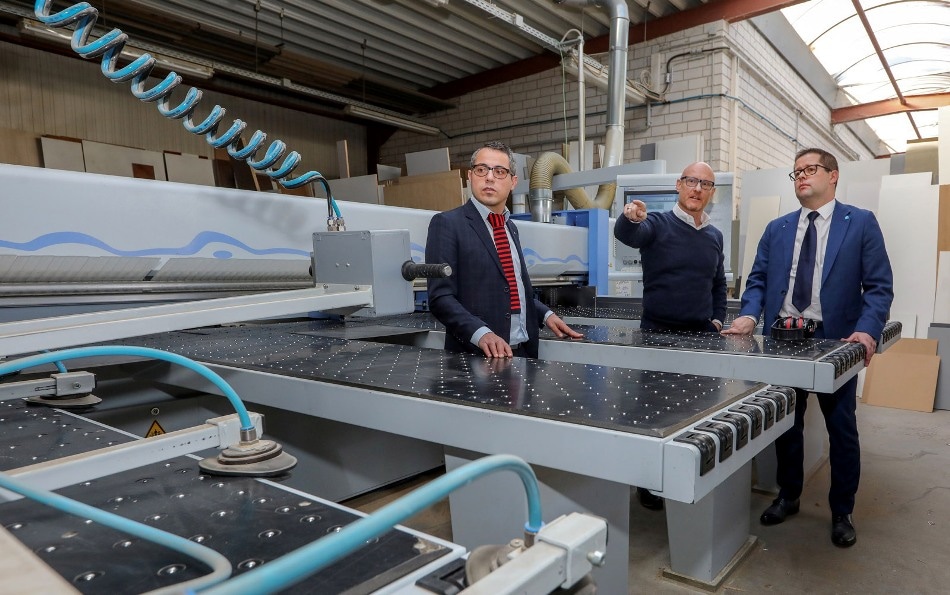May 3 2019
The increasing use of renewable energy sources such as wind power, solar power, and more is leading to considerable variations in energy production.
 Dr Pio Lombardi, Fraunhofer IFF, Timo Hesse, CEO of aRTE Möbel GmbH, and Prof. Przemyslaw Komarnicki, Magdeburg-Stendal University of Applied Sciences (l. to r.), are exploring how a dynamic energy management system can be incorporated in the everyday business routine together in the RELflex project. (Image credit: Fraunhofer IFF/Viktoria Kühne)
Dr Pio Lombardi, Fraunhofer IFF, Timo Hesse, CEO of aRTE Möbel GmbH, and Prof. Przemyslaw Komarnicki, Magdeburg-Stendal University of Applied Sciences (l. to r.), are exploring how a dynamic energy management system can be incorporated in the everyday business routine together in the RELflex project. (Image credit: Fraunhofer IFF/Viktoria Kühne)
Fraunhofer scientists have now enabled industrial processes to be designed in small and medium-sized businesses to make them demand-responsive. This allows firms to increase their use of green power from their own power plants, to respond to fluctuations, and, someday, to contribute to making the energy supply stable.
The quantity of coal in the energy assortment is reducing, while renewables are gradually increasing in significance. However, this is posing challenges to grid operators. If a fresh wind is blowing and the sun is shining bright in a clear blue sky, wind turbines and solar module produce more power than required. However, if the sky is cloudy and the wind is not blowing, there will be a shortage of power. How is it possible to stabilize such production fluctuations to assure a stabilized energy supply, despite the increasing number of volatile power sources?
Flexibly Adapting Production Processes to the Energy Situation
Scientists at the Fraunhofer Institute for Factory Operation and Automation IFF in Magdeburg identify a solution among small and medium-sized industries, which enables them to produce their own power from wind, sun, or even their own manufacturing waste. They will turn out to be more active shareholders in the prospective smart grid, helping to make it more reliable and more stable. Realizing this objective involves developing internal energy-relevant industrial processes that are demand-responsive, handling controllable loads dynamically, producing renewable energy, and using energy storage systems.
We are developing new solutions and applications together with Mageburg-Stendal University of Applied Sciences and other partners in the European project RELflex. They are primarily intended to help make manufacturing processes in SMBs more demand-responsive. That means businesses can adapt their manufacturing processes to the actual energy situation, fall back on energy from their storage systems during bottlenecks, and possibly even use other energy sources such as incinerated wood waste.
Dr Pio Lombardi, RELflex Project Manager, Fraunhofer IFF.
The XDEMS dynamic energy management system is the center of improvement.
Prototype Field Test
The scientists are now studying how this energy management system can be employed in the daily business routine at aRTE Möbel GmbH, one of their project partners. One advantage is that it allows companies to make use of the energy they produce with photovoltaics and the like for their own manufacturing processes, thereby becoming more independent and less reliant on grid operators. Additionally, this has an effect on business models. The bar can be increased for green products, which can be developed using organically produced materials as well as using green energy.
SMBs can respond to the changing energy supply in various methods.
“Adapting manufacturing and installing backup storage systems would be the most efficient way. Whenever a lot of energy is available, items are made to stock and warehoused,” says Lombardi, putting it practically.
The second option would be to allow employees to work flexibly, for example, at later hours or even on weekends, depending on the energy condition. The scientists plan to estimate the acceptance of this proposal in a corresponding survey. Energy storage systems are a promising third option. However, they remain costly due to the high capital expenditures, and energy storage still involves losses, based on the technology.
The Fraunhofer scientists are beginning by concentrating on the monitoring system at aRTE Möbel GmbH. They are employing appropriate instrumentation to determine the energy produced by the private photovoltaic system and the power utilized by individual manufacturing lines or sets of manufacturing lines in real time.
In a second phase, the scientists will be employing their XDEMS software to collect load and production estimates from the recorded data. How much power will be produced by the photovoltaic system next week? How many cabinets and tables must be produced in that period? And what is the best way to control manufacturing in order to manage these two factors optimally, that is, to introduce the least power into the grid and eliminating the need to withdraw power from it?
In all these cases, the software makes pertinent suggestions. A traffic light system might be feasible. For example, a green light could indicate employees that adequate power is being generated and that items can be stored. However, if there is a shortage in energy supply, a red light could show that the line must be used later.
We still have to consult with aRTE Möbel GmbH management about the exact form information feedback to employees will take.
Dr Pio Lombardi, RELflex Project Manager, Fraunhofer IFF.
After they have developed the monitoring system, the scientists will begin to work on the forecasting and control system in the coming year.